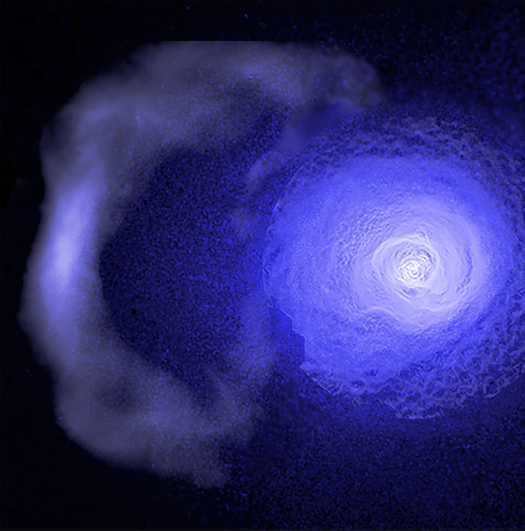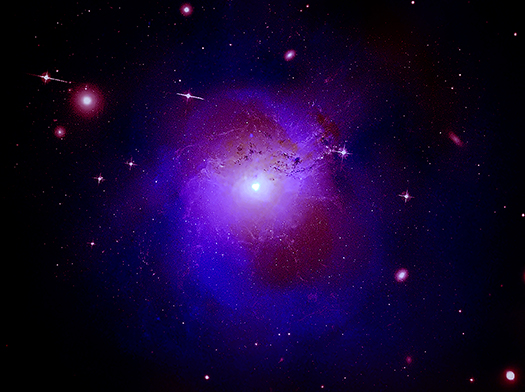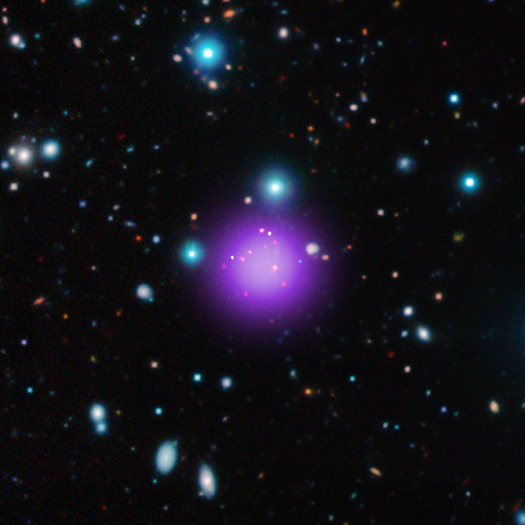Groups & Clusters of Galaxies
To Boldly Go into Colliding Galaxy Clusters
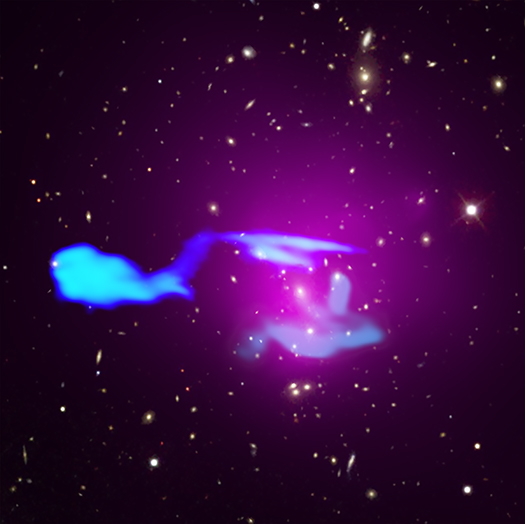
Credit: X-ray: NASA/CXC/Leiden Univ./F. de Gasperin et al;
Optical: SDSS; Radio: LOFAR/ASTRON, NCRA/TIFR/GMRT

USS Enterprise NCC 1701
Credit: Smithsonian National
Air & Space Museum
Hidden in a distant galaxy cluster collision are wisps of gas resembling the starship Enterprise — an iconic spaceship from the "Star Trek" franchise.
Galaxy clusters — cosmic structures containing hundreds or even thousands of galaxies — are the largest objects in the Universe held together by gravity. Multi-million-degree gas fills the space in between the individual galaxies. The mass of the hot gas is about six times greater than that of all the galaxies combined. This superheated gas is invisible to optical telescopes, but shines brightly in X-rays, so an X-ray telescope like NASA's Chandra X-ray Observatory is required to study it.
Making Head or Tail of a Galactic Landscape
Astronomers have used data from NASA's Chandra X-ray Observatory to capture a dramatic image of an enormous tail of hot gas stretching for more than a million light years behind a group of galaxies that is falling into the depths of an even-larger cluster of galaxies. Discoveries like this help astronomers learn about the environment and conditions under which the Universe's biggest structures evolve.
Galaxy clusters are the largest structures in the Universe held together by gravity. While galaxy clusters can contain hundreds or even thousands of individual galaxies, the lion's share of mass in a galaxy cluster comes from hot gas, which gives off X-rays, and unseen dark matter. How did these cosmic giants get to be so big?
Perseus’s Cosmic Dance Helps Reveal the Secrets of Galaxy Cluster Astrophysics

Stephen A. Walker
We welcome Stephen A. Walker, first author on our latest results from the Perseus galaxy cluster, as our guest blogger. Originally from the UK, Stephen received his PhD at the University of Cambridge, continuing there as a postdoc, before becoming a NASA Postdoctoral Program Fellow at NASA’s Goddard Space Flight Center.
The story begins in October 2010, when I started my PhD at the University of Cambridge. I was exploring new X-ray observations of the outskirts of galaxy clusters taken with Suzaku. Much like in a city, the outskirts are where clusters continue to grow outwards.
Galaxy clusters are the largest gravitationally bound structures of the universe, consisting of hundreds or thousands of galaxies. The total masses of clusters are colossal, reaching up to and beyond a million billion times the mass of the sun. The vast majority of the ‘normal’ matter in these clusters (like hydrogen and helium) does not actually lie in the galaxies themselves, but rather in an extremely hot and diffuse gas between the galaxies, called the intracluster medium.
As the largest gravitationally bound structures in the universe, galaxy clusters continue to grow and accrete matter from the surrounding cosmic web of gas produced by the Big Bang. When the infalling gas falls into their deep gravitational potential wells, it is shock heated to tens of millions of degrees, and begins to emit prodigiously in the X-ray band.
A Cosmic Cold Front in the Perseus Cluster
A gigantic and resilient "cold front" hurtling through the Perseus galaxy cluster has been studied using data from NASA's Chandra X-ray Observatory. This cosmic weather system spans about two million light years and has been traveling for over 5 billion years, longer than the existence of our Solar System.
This graphic shows the cold front in the Perseus cluster. The image above contains X-ray data from Chandra — for regions close to the center of the cluster —along with data from ESA's XMM-Newton and the now-defunct German Roentgen (ROSAT) satellite for regions farther out. The Chandra data have been specially processed to brighten the contrast of edges to make subtle details more obvious.
Perseus Cluster: A New Twist in the Dark Matter Tale
An innovative interpretation of X-ray data from a galaxy cluster could help scientists understand the nature of dark matter, as described in our latest press release. The finding involves a new explanation for a set of results made with NASA's Chandra X-ray Observatory, ESA's XMM-Newton and Hitomi, a Japanese-led X-ray telescope. If confirmed with future observations, this may represent a major step forward in understanding the nature of the mysterious, invisible substance that makes up about 85% of matter in the Universe.
Is Dark Matter "Fuzzy"?
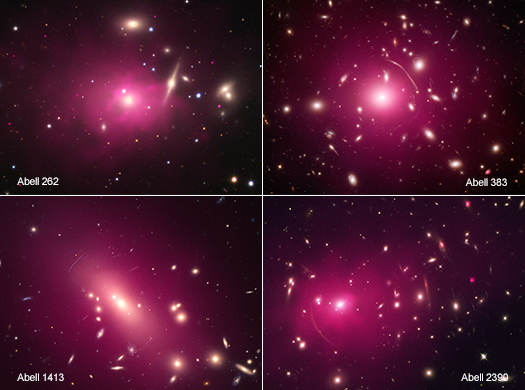
Four of the 13 galaxies clusters used in the study. The clusters are, starting at the top left
and going clockwise, Abell 262, Abell 383, Abell 1413, and Abell 2390.
Astronomers have used data from NASA's Chandra X-ray Observatory to study the properties of dark matter, the mysterious, invisible substance that makes up a majority of matter in the universe. The study, which involves 13 galaxy clusters, explores the possibility that dark matter may be more "fuzzy" than "cold," perhaps even adding to the complexity surrounding this cosmic conundrum.
For several decades, astronomers have known about dark matter. Although it cannot be observed directly, dark matter does interact via gravity with normal, radiating matter (that is, anything made up of protons, neutrons, and electrons bundled into atoms). Capitalizing on this interaction, astronomers have studied the effects of dark matter using a variety of techniques, including observations of the motion of stars in galaxies, the motion of galaxies in galaxy clusters, and the distribution of X-ray emitting hot gas in galaxy clusters. Dark matter has also left an imprint on the radiation left over from the Big Bang 13.8 billion years ago.
The Discovery of Particle Re-acceleration in a Galaxy Cluster Collision

Felipe Andrade-Santos and Reinout van Weeren
For this guest blog post, we are lucky to have not one, but two, contributors. Reinout van Weeren obtained his PhD from Leiden University, The Netherlands, before moving to the Harvard-Smithsonian Center of Astrophysics as an Einstein Postdoctoral Research Fellow. He is currently a Clay Fellow at the same place. He works on merging galaxy clusters, focusing on combined radio and X-ray observations. Felipe Andrade-Santos obtained his PhD from the Universidade de São Paulo, Brazil, before becoming a postdoctoral research fellow at the Harvard-Smithsonian Center of Astrophysics. He works on X-ray observations of galaxy clusters and galaxy cluster samples. Reinout and Felipe recently presented their study on the merging galaxy cluster system Abell 3411 and 3412 at the 229th meeting of the American Astronomical Society meeting in January 2017.
Galaxy clusters are the most massive objects in the Universe bound together by gravity and contain up to a few thousand galaxies. They are also permeated by very thin 100-million-degree gas that is held together by the cluster's strong gravitational pull. This hot gas can be imaged with X-ray satellites such as NASA's Chandra X-ray Observatory. Galaxy clusters form by mergers of smaller clusters and galaxy groups. During a merger event, which typically lasts for about a billion years, the galaxies mostly fly past each other without strongly interacting. In contrast, the diffuse gas in the merging clusters collides, creating giant shock waves, which are cosmic versions of sonic booms generated by supersonic aircraft. Cluster mergers have been of great interest to astronomers and us because of the extreme physical processes that take place during such events.
Radio telescopes have shown that large regions of merging galaxy clusters glow at radio wavelengths. The radio emission is produced by tiny particles, called electrons, which spiral around magnetic field lines and have energies that are a million times higher than the particles making up the hot cluster gas. Astronomers have long been puzzled by how these energetic electrons are produced. One idea is that the energetic particles are accelerated to these extreme energies by shocks created when clusters collide and merge.
Hunting For the Most Distant Galaxy Cluster

Tao Wang
We are pleased to welcome Dr. Tao Wang as a guest blogger. Tao is the first author of a paper that is the subject of our latest press release, about an extremely distant galaxy cluster. Tao is now a postdoc in CEA/Saclay, France, working with Dr. David Elbaz on high-redshift galaxies and galaxy clusters, and received a PhD in astrophysics from Nanjing University, China in 2012. During his PhD, he worked for two years in the Harvard-Smithsonian Center for Astrophysics and then worked as an associate researcher back in Nanjing University for one year before starting his postdoctoral work at CEA/Saclay in 2013.
Galaxy clusters are the largest known gravitationally bound structures in the universe and usually consist of hundreds of galaxies distributed in a relatively small area a few million light-years across. One of the most prominent features of clusters is the presence of a predominant population of massive, elliptical galaxies in the cluster core. These galaxies are among the most massive galaxies in the universe and are believed to have rapidly formed their stars a long time ago. However, how these galaxies formed and why have they stopped forming new stars remain mysteries. Solving these mysteries is essential to our understanding of both galaxy and cluster formation. To answer these questions, the key is to search for and study galaxy clusters (or their progenitors) in the early universe, right when they form.
Record-breaking Galaxy Cluster Discovered
This image contains the most distant galaxy cluster, a discovery made using data from NASA's Chandra X-ray Observatory and several other telescopes. The galaxy cluster, known as CL J1001+0220, is located about 11.1 billion light years from Earth and may have been caught right after birth, a brief, but important stage of cluster evolution never seen before.
"Russian Doll" Galaxy Clusters Reveal Information About Dark Energy
We are happy to welcome Dr. Andrea Morandi as our guest blogger, who is giving us insight into his recent work on using galaxy clusters to investigate the nature of dark energy. Originally from Italy, Dr. Morandi received his Ph.D. in astronomy from the University of Bologna. Prior to his current position as a research assistant at the University of Alabama in Huntsville, Dr. Morandi was a post-doctoral fellow at the DARK Cosmology Center in Copenhagen and Tel Aviv University, followed by time as a research associate at Purdue University.

In 1998 and 1999 astronomers discovered the accelerating expansion of the Universe, providing evidence for the existence of the mysterious dark energy driving this acceleration. The same year I started to study astronomy at the Bologna University, fascinated by this major breakthrough in cosmology. I guess my interest for cosmology started from here.


